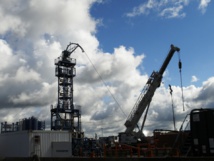Here are the main trends of the gas market in different countries and regions of the world.
Iran and a new contract for gas production
September 30, the Iranian government has approved the new model contract for exploration and production of oil and gas, based on the fact that this model will be a key means of increasing the level of production, stated the Ministry of Petroleum Industry.
Managing Director of National Iranian Oil Company Rokneddin Javadi told the Iranian news agency that many of the major oil companies are once again opening representative offices in Tehran, and he does not exclude the possibility that US companies can come to Tehran to study a new model contract.
He noted that cooperation with US companies under the new contract model "is quite possible and is not subject to any restrictions."
Tehran hopes to raise up to $ 40 billion of foreign investment in the oil and gas sector with this step. This should happen after the sanctions from the country are lifted.
In the meantime, we have a lot of European companies and officials visited Tehran recently. The most recent was the visit of the delegation headed by the Minister of Economy of Poland, which from 2008 to 2011 has been in talks about production at the gas field in the Persian Gulf Laban.
Natural gas in Europe and market changes
Jonathan Stern, an analyst at the British Oxford Institute for Energy Studies, warned Europe that it will have to adapt quickly enough to the changing situation on the global gas market and look for new alternatives of supply.
In an interview to Platts, Stern warns that any surprises in the dynamics of the gas market - such as a sharp increase in demand in Asia - may lead to a shortage of gas in Europe.
The demand for gas in Europe remained reduced after the financial crisis of 2008 against the background of the fact that the gas market has been increasingly globalizing. "The European gas market has not recovered from the recession," - said Stern.
Now, the demand in Europe is still rather low, while there are reasons for concern in the domestic market. Stern points out on the three countries in the region, producing natural gas: the United Kingdom, the Netherlands and Norway. They account for 80% of gas production within Europe.
Stern noted that gas production could fall to 100 billion cubic meters by 2030. "The decline in production in the UK is quite predictable, as the production has already leveled off and will begin to decline in the early 2020s." - said Stern.
Stern also said that other options for domestic supplies are scarce.
He also write off the prospects of shale gas in Europe in the near future: "There is a lot of hype and excitement around the shale gas in Europe. For me, all of this is a waste of time in the context of production in the short term."
At the time, Stern notes that Europe can benefit from construction of new pipelines with which it will import gas from other countries.
Currently, there are three major projects under construction that would give Europe the ability to import the necessary amount of gas.
LNG in the US - new projects and the world market
Fereidun Fesharaki, the chairman and founder of FGE, notes that 10 projects, submitted for approval in the Federal Commission for regulation in the energy sector, may threefold increase the volume of gas in the United States.
"Where will these volumes go? Who will buy this?" - he asks.
The projects represent about 180 million tons, said Fesharaki. "Nobody in the world will not allow it. It's too much," - he said. He estimated that the decline in oil prices will be followed by the weakening of demand for LNG.
Demand in Japan has certainly peaked, the analyst said. Given the expectation that the country recovers nuclear energy and energy will be produced with nuclear power and coal, Japan is unlikely to increase the consumption of gas, which will account for 20-25%, maximum 30%, compared with today’s 48%.
His analysis of prospects in South Korea was as bleak, since the demand for LNG in the market is constantly decreasing. A few years ago, there was a point that demand will grow, said Fesharaki, but now coal is back on the market. According to him, in 2020, LNG demand will increase slightly, but not critical.
Nevertheless, he identified a number of promising markets for LNG - Indonesia, Thailand, Kuwait and the UAE.
Growth prospects in Asia
Reduction of the forecast on growth in the economies of China and India and the slow recovery of the largest developed economies - all this will lead to the fact that the rate of growth of Asian economies will be lower than forecast in 2015 and in 2016, says the Asian Development Bank in the report.
Despite the fact that the level of growth in developed countries will be lower than the forecast, there are favorable signs of economic growth of the Eurozone and the United States.
In its annual economic review “The Asian Development Outlook”, the bank notes that the region's GDP will grow by 5.8% in 2015 and 6.0% in 2016. This is slightly lower than the previous forecast of 6.3%.
"A significant proportion of world economic growth will continue to account for the developing countries of Asia, despite the reduction of growth", - the report says.
India is stepping up LNG imports
India will import about 13.5 million cubic meters of LNG per day for the next 6 months, starting in October. These volumes will require the country to buy fuel for businesses, left without gas as a result of falling domestic production.
The government announced the resumption of work at 13 power plants on natural gas, which has been purchased as part of tender.
Domestic gas prices are significantly lower than the price of imported LNG. Virtually all state power stations are in a difficult financial situation, so they do not really want to buy more expensive imported LNG.
The lack of domestic gas has led to the fact that many power stations have suspended work. In 2014, power plants, running on gas, accounted for only 21% of total electricity generation.
However, the programme on cutting costs of imported gas, announced in March 2015, offered financial assistance to businesses. The implementation of the program has led to the growth of LNG imports. The main goal of the program is increase in power generation and use of LNG terminals and pipelines.
China hopes for Russian gas
China hopes to be importing up to 100 billion cubic meters of pipeline gas and LNG from Russia by 2020 – it is about a third of the total consumption of China. China views Russia as a strategic partner, says the Chinese oil company CNPC.
The Russian company "Gazprom" and Chineze CNPC signed two 30-year contracts, which together cover supply in amount of 68 billion cubic meters per year to China from fields in Western Siberia.
They also signed a memorandum of understanding to supply 15 billion cubic meters per year from Russia to China. Deliveries of the first project - "The Power of Siberia" - will begin in 2018, and the construction of the pipeline is already underway.
Long-term partnership between China and Russia will also include cooperation in the supply of LNG, in addition to the pipeline projects.
Unlike pipeline gas, Russian LNG faces competition from Australia, the Middle East and Africa - they already supply LNG to China. However, these supplies are very expensive, which is why CNPC is so interested in Russia.
source: platts.com
Iran and a new contract for gas production
September 30, the Iranian government has approved the new model contract for exploration and production of oil and gas, based on the fact that this model will be a key means of increasing the level of production, stated the Ministry of Petroleum Industry.
Managing Director of National Iranian Oil Company Rokneddin Javadi told the Iranian news agency that many of the major oil companies are once again opening representative offices in Tehran, and he does not exclude the possibility that US companies can come to Tehran to study a new model contract.
He noted that cooperation with US companies under the new contract model "is quite possible and is not subject to any restrictions."
Tehran hopes to raise up to $ 40 billion of foreign investment in the oil and gas sector with this step. This should happen after the sanctions from the country are lifted.
In the meantime, we have a lot of European companies and officials visited Tehran recently. The most recent was the visit of the delegation headed by the Minister of Economy of Poland, which from 2008 to 2011 has been in talks about production at the gas field in the Persian Gulf Laban.
Natural gas in Europe and market changes
Jonathan Stern, an analyst at the British Oxford Institute for Energy Studies, warned Europe that it will have to adapt quickly enough to the changing situation on the global gas market and look for new alternatives of supply.
In an interview to Platts, Stern warns that any surprises in the dynamics of the gas market - such as a sharp increase in demand in Asia - may lead to a shortage of gas in Europe.
The demand for gas in Europe remained reduced after the financial crisis of 2008 against the background of the fact that the gas market has been increasingly globalizing. "The European gas market has not recovered from the recession," - said Stern.
Now, the demand in Europe is still rather low, while there are reasons for concern in the domestic market. Stern points out on the three countries in the region, producing natural gas: the United Kingdom, the Netherlands and Norway. They account for 80% of gas production within Europe.
Stern noted that gas production could fall to 100 billion cubic meters by 2030. "The decline in production in the UK is quite predictable, as the production has already leveled off and will begin to decline in the early 2020s." - said Stern.
Stern also said that other options for domestic supplies are scarce.
He also write off the prospects of shale gas in Europe in the near future: "There is a lot of hype and excitement around the shale gas in Europe. For me, all of this is a waste of time in the context of production in the short term."
At the time, Stern notes that Europe can benefit from construction of new pipelines with which it will import gas from other countries.
Currently, there are three major projects under construction that would give Europe the ability to import the necessary amount of gas.
LNG in the US - new projects and the world market
Fereidun Fesharaki, the chairman and founder of FGE, notes that 10 projects, submitted for approval in the Federal Commission for regulation in the energy sector, may threefold increase the volume of gas in the United States.
"Where will these volumes go? Who will buy this?" - he asks.
The projects represent about 180 million tons, said Fesharaki. "Nobody in the world will not allow it. It's too much," - he said. He estimated that the decline in oil prices will be followed by the weakening of demand for LNG.
Demand in Japan has certainly peaked, the analyst said. Given the expectation that the country recovers nuclear energy and energy will be produced with nuclear power and coal, Japan is unlikely to increase the consumption of gas, which will account for 20-25%, maximum 30%, compared with today’s 48%.
His analysis of prospects in South Korea was as bleak, since the demand for LNG in the market is constantly decreasing. A few years ago, there was a point that demand will grow, said Fesharaki, but now coal is back on the market. According to him, in 2020, LNG demand will increase slightly, but not critical.
Nevertheless, he identified a number of promising markets for LNG - Indonesia, Thailand, Kuwait and the UAE.
Growth prospects in Asia
Reduction of the forecast on growth in the economies of China and India and the slow recovery of the largest developed economies - all this will lead to the fact that the rate of growth of Asian economies will be lower than forecast in 2015 and in 2016, says the Asian Development Bank in the report.
Despite the fact that the level of growth in developed countries will be lower than the forecast, there are favorable signs of economic growth of the Eurozone and the United States.
In its annual economic review “The Asian Development Outlook”, the bank notes that the region's GDP will grow by 5.8% in 2015 and 6.0% in 2016. This is slightly lower than the previous forecast of 6.3%.
"A significant proportion of world economic growth will continue to account for the developing countries of Asia, despite the reduction of growth", - the report says.
India is stepping up LNG imports
India will import about 13.5 million cubic meters of LNG per day for the next 6 months, starting in October. These volumes will require the country to buy fuel for businesses, left without gas as a result of falling domestic production.
The government announced the resumption of work at 13 power plants on natural gas, which has been purchased as part of tender.
Domestic gas prices are significantly lower than the price of imported LNG. Virtually all state power stations are in a difficult financial situation, so they do not really want to buy more expensive imported LNG.
The lack of domestic gas has led to the fact that many power stations have suspended work. In 2014, power plants, running on gas, accounted for only 21% of total electricity generation.
However, the programme on cutting costs of imported gas, announced in March 2015, offered financial assistance to businesses. The implementation of the program has led to the growth of LNG imports. The main goal of the program is increase in power generation and use of LNG terminals and pipelines.
China hopes for Russian gas
China hopes to be importing up to 100 billion cubic meters of pipeline gas and LNG from Russia by 2020 – it is about a third of the total consumption of China. China views Russia as a strategic partner, says the Chinese oil company CNPC.
The Russian company "Gazprom" and Chineze CNPC signed two 30-year contracts, which together cover supply in amount of 68 billion cubic meters per year to China from fields in Western Siberia.
They also signed a memorandum of understanding to supply 15 billion cubic meters per year from Russia to China. Deliveries of the first project - "The Power of Siberia" - will begin in 2018, and the construction of the pipeline is already underway.
Long-term partnership between China and Russia will also include cooperation in the supply of LNG, in addition to the pipeline projects.
Unlike pipeline gas, Russian LNG faces competition from Australia, the Middle East and Africa - they already supply LNG to China. However, these supplies are very expensive, which is why CNPC is so interested in Russia.
source: platts.com



















